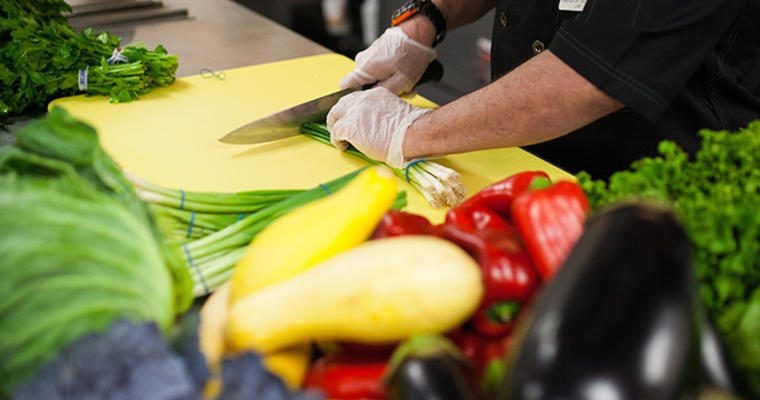Food waste is a key focus for many foodservice operators, and rightfully so. But it’s not just about sustainability, as previously touted. Reduce waste and you’ll reduce cost—it’s that simple.
For the biggest impact, start by reducing the amount of produce you waste. Fruits and vegetables have a 45-percent wastage rate—the highest of any food products, according to the Food and Agriculture Organization of the United Nations.
Not Sure Where to Start? Try These Proven Tactics for Reducing Produce Waste
Inspect Produce on Arrival
Patricia Guerrero, Senior Marketing Communication Manager for Cambro, a California-based foodservice-equipment supplier, recommends examining all food orders as they come in. Do a random check of items—not just those on top—and reject anything that’s spoiled or is heading that way.
Store Products Properly
Based on third-party research, Guerrero suggests storing produce in sealed containers. This practice, she says, can extend produce life two to three days longer than leaving it uncovered or wrapping it in foil or plastic will.
Holding products at the proper temperature is also critical, maintains Tim York, President of Markon, a California-based fresh-produce supplier. Storage below ideal temperatures risks chilling injury and inhibition of full ripening, but at the right temperature, produce will last longer. “Once you cut a plant from the field, it’s in the process of dying,” he says. “Refrigeration slows that process.”
Label and Rotate Items
Use food labels to identify items and to note the date when you received them. Use the first in, first out (FIFO) method to ensure that older product is used first.
Maintain Coolers
Clean coolers regularly and remove any food that’s fallen behind the shelves. Monitor the thermometer to be certain your cooler is working properly. Keep ventilation running efficiently to reduce Ethylene concentrations.
Monitor Produce Waste
Ask staff to collect all produce trimmings in one waste bucket. At the end of each shift, examine the contents with employees, looking for product that is still usable. Could you cut around the bruise in the tomato and use the remainder for the salad bar?
Or, try an automated system like LeanPath. It monitors all the food that gets thrown away every day and focuses employees on waste prevention. The typical operator cuts food waste in half, reports LeanPath CEO Andrew Shakman, and saves 2 percent to 6 percent of its annual food costs this way.
Whichever method you choose, measuring waste helps you identify areas for improvement and devise strategies for addressing them.
Watch the Trim
Overtrimming is a major culprit in pre-consumer food waste—food discarded by the foodservice department before it reaches a consumer’s plate, such as a quarter of each strawberry being lopped off along with the stem. If you detect a pattern of overtrimming, give staff a refresher course on properly slicing and trimming foods—and ensure that they have access to appropriately-sharpened knives.
Watch Plates
Pay equal attention to post-consumer waste—what’s left on the plate after diners are finished. Conduct regular plate-waste studies to determine if you need to pull back on any items.
Adjust Your Orders
Excess waste can be a signal to modify your purchasing. Are you ordering more than you need or specifying too-large pack sizes? Buying in bulk doesn’t save money if you’re throwing some of it away each week.
Go Value-Added
Supplement your fresh produce purchases with frozen vegetables and pre-cut slaw mixes, which are zero waste. Indeed, York adds, “Our Ready-Set-Serve® line offers 100-percent usable product, along with a ‘best-if-used-by’ date on each package, so operators can better monitor inventory.”
Keep in mind that “best if used by” is a guideline, not a definitive date. “That date ensures optimum texture, color, and crispness,” York explains. “But the product may still be usable some days after that.” However, always label your items with open and use by dates and follow food code standards of when to throw it out.
Go Root to Stem
There’s a growing trend to reduce produce waste by using the entire product. “Chefs are putting broccoli leaves into salads and shaving stems into slaws,” York says. Also consider using carrot greens in pestos, or simmering vegetable peels into broths for savory flavor. “It’s the equivalent of snout-to-tail cooking on the meat side.”
Focusing on reusing as much product as possible also helps reduce waste. Chefs can be a big help here if you train them to think about what to do with the leftovers as soon as a meal is finished. For example, if you serve California-blend vegetables for lunch, immediately puree the leftovers and use them as a base for a soup.
Follow these procedures, and you’ll be well on your way to reduced waste and increased savings.




























